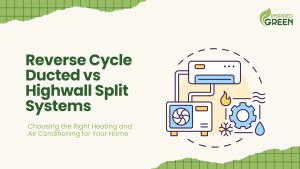When it comes to creating a comfortable environment at home or in the office, choosing the right heating and cooling system is essential. There are numerous options available, but it always comes back to the same two questions:
- Ducted or Split?
- Gas or Electric?
In this blog article, we will provide the answers to these questions, helping you decide once and for all if you should install ducted air conditioning or split systems in Melbourne.
Reverse Cycle Air Conditioning: Energy-Efficient Heating and Cooling

The good news is that whether you choose a split system unit or a ducted unit, you will benefit from reverse cycle air conditioning technology. Reverse cycle systems offer energy-efficient heating and cooling from one unit, eliminating the need for separate heaters and coolers. This not only saves you money upfront but also provides year-round comfort, lower electricity bills, and a reduced carbon footprint.
Reverse cycle systems are up to 600% efficient because they transfer heat rather than generate it. You can learn more about how reverse cycle air conditioners work here.
Gas or Electric?

The answer to this is clear: opt for an electrically powered reverse cycle system. Electric heating and cooling are the future, offering superior efficiency and environmental benefits compared to traditional gas ducted systems.
What Are Highwall Split Systems?

Highwall split systems, also known as ductless systems, consist of two main components: an indoor unit and an outdoor unit. The indoor unit distributes heated or cooled air directly into the room, while the outdoor unit houses the compressor and other components. These systems are perfect for heating or cooling individual rooms or areas, making them ideal for bedrooms, living rooms, home offices, and small office spaces.
Pros of Split Systems
- Flexible Installation: Ideal for homes or offices with limited space.
- Energy Efficiency: More efficient for heating or cooling specific areas.
- Cost-Effective: Lower purchase and installation costs.
- Independent Control: Customized temperature control for each room.
- Quiet Operation: Often quieter than central air systems.
- Easy Maintenance: Simpler maintenance compared to ducted systems.
Cons of Split Systems
- Indoor Aesthetics: Visible indoor units might be unappealing.
- Limited Coverage: Better suited for individual rooms.
- Multiple Units Needed: Large homes may require multiple units.
- Uneven Temperatures: Varying temperatures across different rooms.
- Outdoor Unit Placement: Finding an appropriate location can be challenging.
- Installation Limitations: Not suitable for some properties due to installation constraints.
What Is Reverse Cycle Ducted Heating and Cooling?

Reverse cycle ducted systems are central heating and cooling units that distribute air through a network of ducts and vents, making them ideal for large homes and buildings. They offer seamless, whole-home coverage and maintain consistent temperatures throughout the property.
Pros of Ducted Systems
- Whole-Home Coverage: Efficiently heats and cools an entire building.
- Aesthetics: Hidden ducts and vents create a seamless look.
- Zoning: Independent temperature and airflow control in different areas.
- Year-Round Comfort: Heating and cooling from one unit.
- Consistent Temperature: No more hot or cold spots.
- Increased Property Value: Adds value and appeal to properties.
Cons of Ducted Systems
- Cost: Higher purchase, installation, and maintenance costs.
- Installation Complexity: More complicated, especially in existing buildings.
- Limited Individual Control: Zoning may not offer the same level of control as split systems.
- Potential for Air Leakage: Decreased energy efficiency if ductwork is not properly sealed.
Ducted vs Split – What’s Best?

When choosing between a ducted or split system, consider factors such as your budget, the size of your space, and your aesthetic preferences. Split systems are generally more suitable for smaller homes, apartments, or offices, while ducted systems are often better for larger homes or buildings.
If you have design limitations that make it difficult to install ductwork, split systems are a great solution. They also complement existing ducted systems if you’re adding an extra room to your home or want dedicated climate control in a specific space.
For whole-home heating and cooling with the option for individual room control via zoning technology, a ducted unit is best. While you can heat and cool your entire home with multiple split systems, a central unit is generally more efficient.
If you’re building a new home, consider ducted reverse cycle air conditioning. Electrically powered homes are the way of the future, and it’s easiest to install ducted systems during construction.
Find Out Which Type of Air Conditioner Is Right for You

To learn more about ducted air conditioning systems and split system air conditioning units, chat with the team at Inspired Green. As Melbourne’s Masters of Heating and Cooling, we can guide you through the most popular types of air conditioning and recommend the best system for your home.
For expert advice and reliable heating solutions, contact Inspired Greens today !








